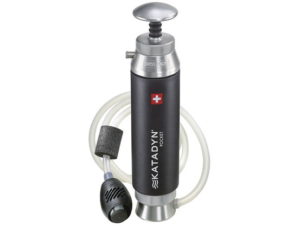Katadyn Pocket

TYPES OF CONTAMINATION
PATHOGENIC MICROORGANISMS

PROTOZOA (AMOEBAE, GIARDIA, LAMBLIA, CRYPTOSPORIDIA)
- Animal single-cell organisms, 1 – 15 microns* in size, which like bacteria get into drinking water through animal and human feces
- These hard-shelled parasites form cysts, which lead to acute gastrointestinal diseases in humans
- Common in unfiltered surface water. Have also been found in drinking water (Milwaukee, London, Sydney)
- A single cell is all it takes for an infection

BACTERIA (E-COLI, SALMONELLA, CHOLERA)
- Single-cell organism 0.2 – 5 microns* in size
- Propagate quickly in warm environments and particular in water,depending on the supply of nutrients
- Become dangerous if they are mixed together with human and animal feces in the drinking water

VIRUSES (HEPATITIS A, NORWALK VIRUS, ROTA VIRUS, POLIO VIRUS)
- Tiny parasites 0.02 – 0.2 microns*
- Can only propagate in living cells since they do not possess their own metabolism
- Get into drinking water through animal and human feces
- Near populated areas, where wastewater can get into drinking water
A large number of additional pathogens are known besides the germs listed above. But according to the World Health Organization (WHO), their pathogenic (disease-inducing) action is only slight, or they are primarily absorbed along with food.
DISTRIBUTION IN WATER

NUTRIENTS
In the muddy bottom, bacteria will quickly multiply due to an excellent supply of nutrients. If possible, do not put the inlet filter into the mud when pumping.
WATER TEMPERATURE
Elevated temperatures promote the growth of bacteria. In standing and slow-moving waters, it is warmer on the surface. Deeper waters are not as contaminated.
CONCENTRATION
Quick-flowing waters are less contaminated since the water is more turbulent and is always being diluted. However disturbed sand may clog the filter.
DANGERS

LOWEST DANGER OF INFECTION ABOVE VEGETATION LIMIT
The risk is much less, as there are fewer germs. At this altitude, the streams flow directly from the sources.
MEDIUM DANGER OF INFECTION BELOW VEGETATION LIMIT
Intensive farming increases the level of bacteria and protozoa contamination in natural waters.
HIGHEST LEVEL OF CONTAMINATION IN HABITATION ZONE
Insufficient treatment of sewage in inhabited areas of developing countries and in fast growing urban areas make the drinking water unsafe.
DIFFERENT COUNTRIES, DIFFERENT RISKS
Every country and continent has to deal with various pathogens in the drinking water. The world maps provide an overview of the distribution of the various diseases resulting from these pathogens.



